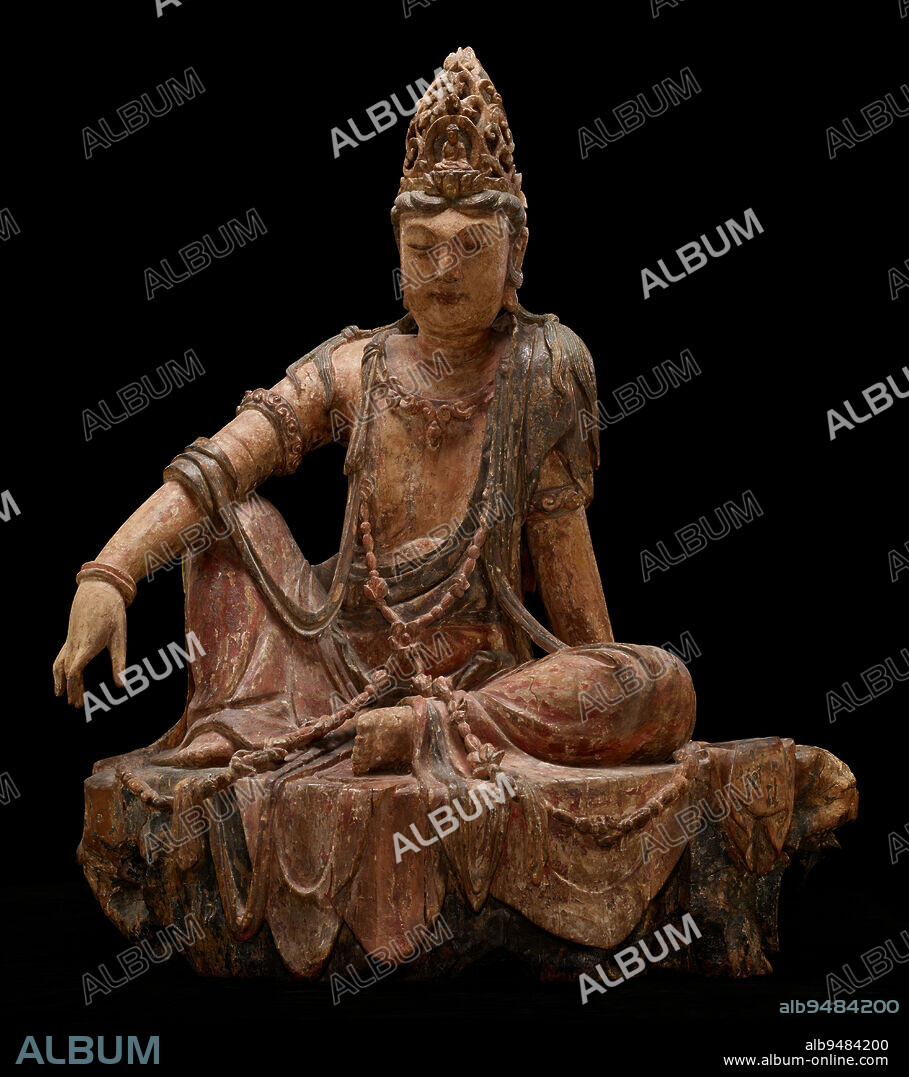alb9484200
Avalokiteshvara Bodhisattva in the Water-Moon Form (Shuiyue Guanyin), 12th century, 40 1/2 x 33 1/2 x 20in. (102.9 x 85.1 x 50.8cm), Wood, gesso and pigments, China, 12th century, Of the many manifestations of the bodhisattva Avalokiteshvara, perhaps none was more prevalent in East Asia than the uniquely Chinese form known as 'Water-Moon Avalokiteshvara,' which later also spread to Korea and Japan. This form of the bodhisattva presides over his own paradise, Potolaka, which is described in scripture as a rugged seaside cave from which Avalokiteshvara could admire the reflection of the moon in the water. Appropriately, he appears meditative and relaxed and is seated informally in the 'royal-ease' posture. Ornately dressed, with silk robes, fluttering sashes, jewelry, and an elaborate hairstyle, he also wears a headpiece that features an image of Amitbha, the buddha to whom Avalokiteshvara attends. Believers might look to a sculpture like this as a guide for their own journeys toward enlightenment.

|
Zu einem anderen Lightbox hinzufügen |
|
Zu einem anderen Lightbox hinzufügen |



Haben Sie bereits ein Konto? Anmelden
Sie haben kein Konto? Registrieren
Dieses Bild kaufen.
Nutzung auswählen:

Untertitel:
Siehe automatische Übersetzung
Avalokiteshvara Bodhisattva in the Water-Moon Form (Shuiyue Guanyin), 12th century, 40 1/2 x 33 1/2 x 20in. (102.9 x 85.1 x 50.8cm), Wood, gesso and pigments, China, 12th century, Of the many manifestations of the bodhisattva Avalokiteshvara, perhaps none was more prevalent in East Asia than the uniquely Chinese form known as 'Water-Moon Avalokiteshvara,' which later also spread to Korea and Japan. This form of the bodhisattva presides over his own paradise, Potolaka, which is described in scripture as a rugged seaside cave from which Avalokiteshvara could admire the reflection of the moon in the water. Appropriately, he appears meditative and relaxed and is seated informally in the 'royal-ease' posture. Ornately dressed, with silk robes, fluttering sashes, jewelry, and an elaborate hairstyle, he also wears a headpiece that features an image of Amitbha, the buddha to whom Avalokiteshvara attends. Believers might look to a sculpture like this as a guide for their own journeys toward enlightenment.
Bildnachweis:
Album / quintlox
Freigaben (Releases):
Model: Nein - Eigentum: Nein
Rechtefragen?
Rechtefragen?
Bildgröße:
5102 x 5749 px | 83.9 MB
Druckgröße:
43.2 x 48.7 cm | 17.0 x 19.2 in (300 dpi)
Schlüsselwörter:
12. JAHRHUNDERT • 12. JH. • BESCHAULICH • FORMULAR • HUT • KLEIDUNG: HUT • KLEIDUNG: MUETZE • KOPFBEDECKUNG • MOND • MUETZE • MÜTZE • NACHDENKLICH • PLASTIKEN • SKULPTUR • SKULPTUREN • SOMBRERO • TECHNIK: SKULPTUR • VIER ELEMENTE: WASSER • WASSER • WASSER, VIER ELEMENTE
 Pinterest
Pinterest Twitter
Twitter Facebook
Facebook Link kopieren
Link kopieren Email
Email
